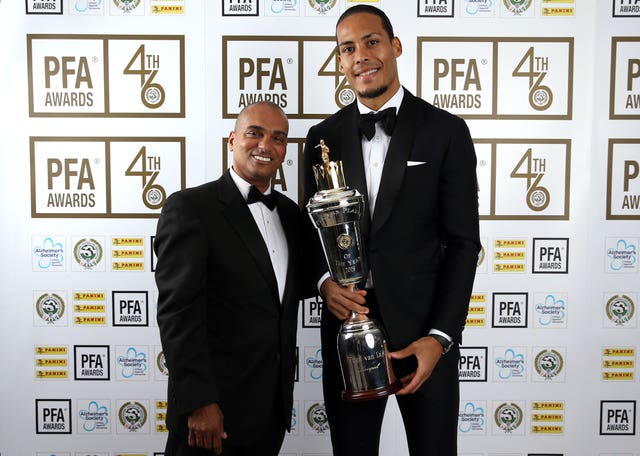Football must immediately ban heading for children 14 and under and permanently substitute any player who has suffered a head injury, according to former player Lenny Johnrose.
The 49-year-old, whose career included spells at Blackburn, Bury, Burnley and Swansea, was diagnosed with motor neurone disease in March 2017.
He said it “sickens” him that no such restrictions on heading are in place in this country, as they are for children under 11 in the United States.
A study published on Monday found footballers were three-and-a-half times more likely to suffer from degenerative brain conditions than the general population. The research looked at 7,676 Scottish footballers born between 1900 and 1976 who were matched with 23,000 people from similar areas and backgrounds.
Within that, there was a four-fold increase in incidence of MND among the footballer group, information which Johnrose says did not come as a surprise.
“At least in America they have done something straight away. We’re taking chances with people’s lives and it does sicken me,” he told the PA news agency.
“I’m going to spend the next few weeks, months, however long it takes speaking to as many authorities as I can to try and get them to do something about it. I don’t see the point in taking that risk.
“It’s not even a big loss, to say, ‘At your age, 14 and under, you’re not heading the ball’. It won’t cause any harm or damage to anybody.”
Former pro footballers had an approx 3.5 times higher rate of death due to neurodegenerative disease, but were less likely to die of diseases such as heart disease and some cancers, says new @UofGMVLS study led by @WillSTEWNeuro in @NEJM 👉 https://t.co/3RlEtHoZx6 pic.twitter.com/imTDKhNyNo — University of Glasgow (@UofGlasgow) October 21, 2019
“I think this is going to go very quiet very quickly unless people like me kick up a bit of a stink and do something about it.
“Whether it’s too late for people like me is irrelevant, we’ve got to think of the future. It’s appalling that we’re trying to play it down, and it feels like they’re going to down tools on it.”
The research published on Monday was funded by the Football Association and the Professional Footballers’ Association.
PFA chief executive Gordon Taylor said in 2017 he would support the introduction of a heading ban for under-11s. Both organisations will await the next phase of the study before deciding what steps need to be taken.
The FA’s independently chaired medical and football advisory group does not yet believe there is enough evidence at this stage to make changes to the way modern-day football is played, at any level of the game.
It has reissued best practice coaching advice in youth football, which advises limiting repetitive heading practice and using age-appropriate balls and softer items like balloons or sponge balls.
Concussion substitutes are being looked at by the game’s law-making body the International Football Association Board this week, but Johnrose insists no chances should be taken in this area either.
“The football industry is so focused on finance that we completely shelve our responsibilities to people’s welfare,” he said.
“The squads are big enough anyway, why have a concussion sub so you can assess the guy and put him back on? Sport is a bit weird. One strike (and come off), don’t take any chances.”
Johnrose recalled numerous occasions during his own playing career where he would play on after a suspected concussion, and then play again within a couple of days.
“I was knocked out and I was in no fit state to carry on at all. I attempted to but eventually I was taken off,” he said.
“But the fact is within a couple of days when you’ve got another game, you’re back in. I am as culpable as anyone because I could have said, ‘I don’t want to play’. But you don’t want to do that. Managers and medics are there to take that decision out of your hands.”
PFA deputy chief executive Bobby Barnes revealed on Monday that he and other ex-professionals have pledged to donate their brains to scientific research after their deaths.

Johnrose said he would do the same “in a heartbeat” and added: “It’s a fantastic gesture, it really is. But the caveat is something could be being done about it now.”
Motor neurone disease is a fatal condition with no cure that affects the brain and nervous system.
Johnrose is involved in Project 92, which intends to visit all professional clubs to raise awareness of the disease and raise funds for research into it.
He admits he experienced suicidal thoughts after his diagnosis, but said going public about the illness worked wonders for him.
💙 It was a pleasure to welcome @LJohnrose to Springfields today to share his inspirational message with the #pnefc players and staff about his @TrustLen 'Project 92', which is raising money and awareness for @mndassoc. Read more ➡️ https://t.co/4jRgRo3SYG pic.twitter.com/Igfkj3hcZY — Preston North End FC (@pnefc) March 19, 2019
His family at home – wife Nadine and children Patrick, 13, and Elizabeth, 16 – are his most important support network.
“The children have got a lot more to do because I can’t contribute physically. For half-term they’ve got a list of jobs as long as your arm, they’re having to be grown-ups almost with the things that they’re doing,” he said.
“They don’t complain, they help me get dressed daily and it’s stuff they shouldn’t have to do. They sometimes must think, ‘I’ve had enough of this’, but they never let it show. In the garden we’ve got a football net and I used to play out there with my son. I can’t do that any more and I know it must be killing them inside but they are such good children, we just get by.
“The hardest thing for me is seeing how worn out they are, but I couldn’t be more proud of them.”






